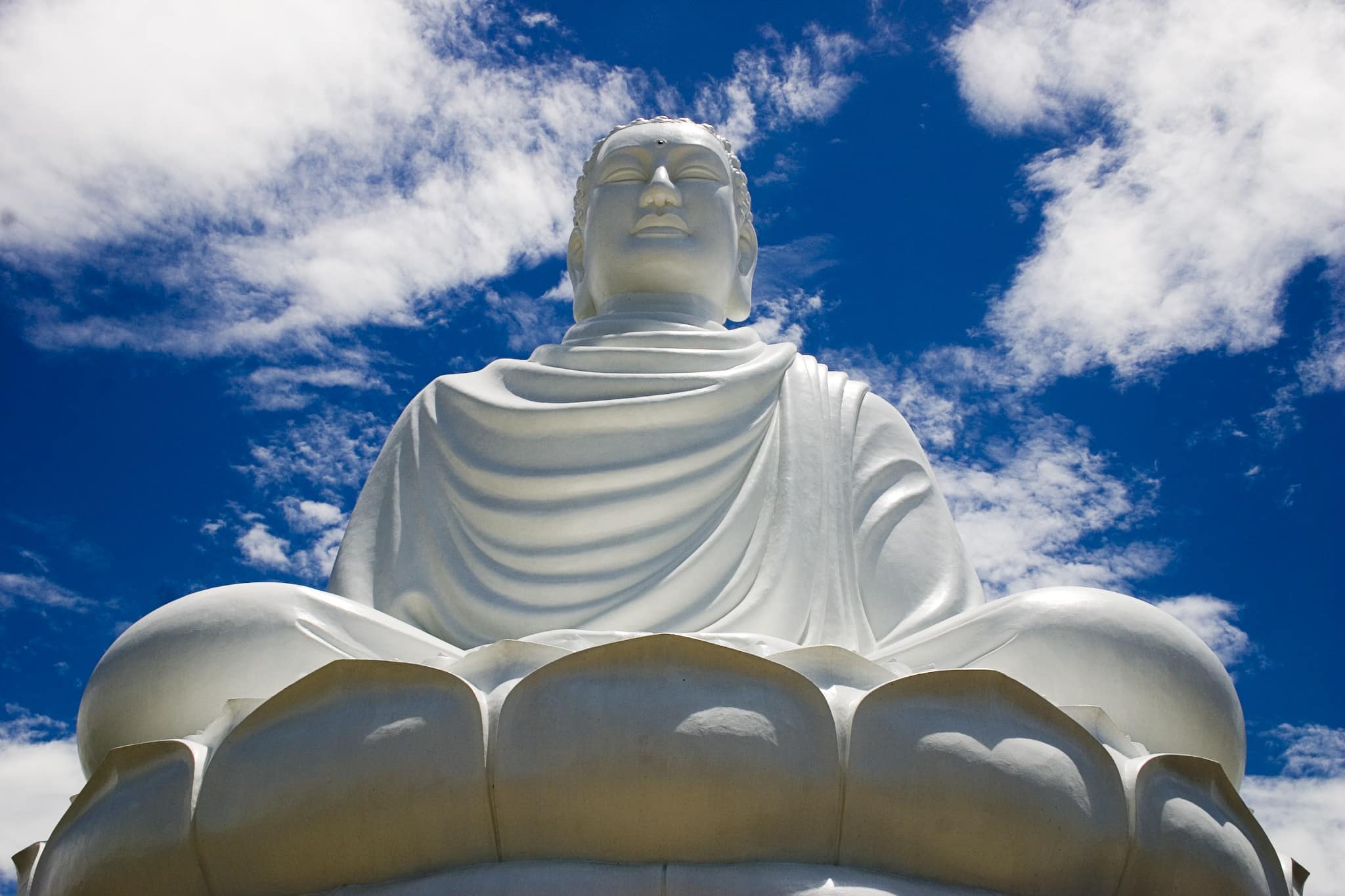Buddhism is named after the Buddha, Siddhartha Gautama, who lived in about 500 CE. He was recognized as the enlightened one, or more literally, “awakened one”. He taught those who followed him how to avoid ignorance and suffering by the paths of knowledge and understanding. By obtaining truth and awareness, they would be granted nirvana, bliss and would become enlightened.
The Buddha was born into a wealthy family; when he was young his father, King Suddhodana, shielded his son from all suffering, because wise men had foretold that the young prince, his son, would become a buddha. His father wanted Siddhartha to become a powerful ruler, so he showered his son in wealth and luxury. But the future Buddha became disillusioned and made four trips outside of his palace free from suffering. On these trips, he saw sickness, then old-age, then death. He despaired; “how can I enjoy luxury when there is so much suffering in the world?” (note the difference between Christ’s acceptance of poverty and suffering in the gardens of Gethsemane). On his fourth trip, the Siddhartha saw a wandering monk who had given up everything he owned to end to suffering. He left his kingdom to wander and find an end to suffering, as the monk had done.
Siddhartha cut his hair and called himself Gautama and for six years he wandered, trying to find the wisest of men to study under. He found no one. For six years he practiced severe asceticism eating almost nothing, until he realized that his hardships would not lead him anywhere. He ended his fast and sat under a Bodhi tree on a full moon, where he began to meditate. But Mara, the evil one, found Siddhartha and tempted him, first with his daughters of desire, then with lightning, rain, wind, and storms, and finally with his demon armies of flame and fire. One by one, the Buddha stood his ground, unmoving from his meditation, defeating them with his virtue.
When the struggle ended, the Buddha gained the most supreme knowledge and wisdom, having cultivated a deep and unceasing awareness. He became the Buddha, or enlightened one, and from then on he was called Shakyamuni Buddha.
“All living beings have the buddha nature and can become buddhas. But you must do your own work, because I can only show you the way.” This is a combination of two quotes from the Buddha that I believe most completely encloses Buddhism. The religion is communally based, on teaching like compassion, love, forgiveness, and teaches detachment from the pleasures of the senses, very similarly to Patanjali’s yoga system. You can see that the Buddha, Patanjali, and Jesus are all very alike in their actual teachings and that there is a tremendous amount of overlap between the three. While they do overlap, each has lessons that are not contained in the other two. All three written collections of work were collected after the death of the primary figure, so much is unknown about each primary figure of the religion. The Buddha’s work was passed down in oral tradition for about 400 years, then transcribed in monasteries.
The Buddha’s teaching is called the middle-way and calls for balance in every aspect of life especially between sensual indulgence and severe asceticism. He taught that the causes of suffering are greed and ignorance and that cause desire for the wrong things and ignorance of the laws of Karma and the function of the universe.
He taught the four Noble Truths, still held by Buddhists today:
- There is suffering that is common to all (babies are born crying, no one wants to die, when we are sick we are miserable, and when we grow old we have pains in the body).
- We are the cause of our own suffering
- To end suffering, we must stop doing what causes suffering
- The path to end suffering can be followed by all, everyone can be enlightened
The path to end suffering is known as The Noble Eightfold Path,  which is represented by a wheel with eight spokes (see right), representing the eight parts of the path, which continues to spin throughout one’s life. The goal is to reach the center of the wheel, also known as Nirvana, or the supreme bliss. This can be equated to Samadhi in yoga, or the ultimate bliss of existence, the highest peaks of meditation. In the eightfold path, samyaksamādhi is known as right concentration which is meditation that leads to increased awareness. Just like every spoke of the wheel is needed for a wheel to keep turning, so is every path needed to attain nirvana.
which is represented by a wheel with eight spokes (see right), representing the eight parts of the path, which continues to spin throughout one’s life. The goal is to reach the center of the wheel, also known as Nirvana, or the supreme bliss. This can be equated to Samadhi in yoga, or the ultimate bliss of existence, the highest peaks of meditation. In the eightfold path, samyaksamādhi is known as right concentration which is meditation that leads to increased awareness. Just like every spoke of the wheel is needed for a wheel to keep turning, so is every path needed to attain nirvana.
The eight paths are as follows:
- Right View – to see the world through wisdom and compassion, or the eyes of the Buddha
- Right Thought – we are a result of what we think; clear and kind thoughts build good and strong character
- Right Speech – speaking kindly and helpfully creates respect and trust from others
- Right Conduct – our words are only words, others know us from the way we behave. Before criticizing others, we must examine ourselves internally
- Right Livelihood – choose a job that does not harm others, do not seek happiness in the unhappiness of others
- Right Effort – a fulfilling life means doing our best at all times and having goodwill towards others and not wasting efforts on things that harm ourselves or others
- Right Mindfulness – being completely aware of your words, deeds, and thoughts to allow cultivation of awareness of your self
- Right Concentration – focus on one object or thought at a time, which will lead to a quiet and truly peaceful mind
Following the path is often compared to growing a garden, where the plants are wisdom, the mind is the ground, and the thoughts are the seeds. Deeds are the way one cares for the garden and our faults are weeds. Pulling the faults as close to the seed as we can so they don’t root into the mind will allow for the garden to grow fully and result in a harvest of love, happiness, and fulfillment.
There may be as many as 1.6 billion Buddhists in the world; it is recognized as one of the world’s fastest growing religions. Devotion is an extremely important part of the practice; you will often see people bowing before statues for long periods of time after a pilgrimage is made to a holy site, or chanting while an offering is burned at the feet of an altar. Buddhist monasteries are some of the oldest human organizations on the planet. They follow Dharma, or the eightfold path, and participate in Sangha, or the monk’s order. Most have obtained one of the four stages of enlightenment which are integrally tied to rebirth. For more on rebirth, see my article on Samsara.
- Stream Enterer – Recognition of Dharma as the path; these beings will be reborn as at least humans
- The Once Returner – one who has had less than seven lives. They have at least one more rebirth before they obtain Moksha, or freedom
- The Non-Returner – this person does not come back to the world, but is birthed into one of the five higher planes of existence, known as Suddhavasa worlds, or “pure abodes” and there they obtain Nirvana
- Arahant – a fully awakened person. This person has abandoned all sensual desires and will not be reborn; they are free from the clutches of Samsara. An Arahant has attained waking from the teachings of the Buddha; the title “Buddha” is reserved for Siddhartha Gautama, who discovered the path for himself.
This is Buddhism’s structure of enlightenment, you can also see some interesting world views in the teachings. Buddhists believe in reincarnation and are trying to obtain liberation from Samsara, the cycle of suffering and life, to achieve Moksha, freedom. Zen Buddhists are simply Buddhists that place extra emphasis on mediation, mostly in China, Korea, and Japan.
As you can see, there are tons of parallels and similarities in the eastern religions; Hinduism, Buddhism, and Jainism have a tremendous amount of overlap.
Honestly, I could write about this type of stuff all day, I could write a post just on the Buddha, or the eightfold path, or enlightenment, or a comparative article between Hinduism and Buddhism. Let me know what you want to read in the comments!

